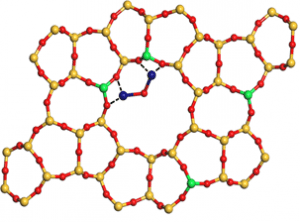
Reported in the February 11, 2021 issue of Nature Catalysis, a research team led by Chao Wang, associate professor in the Department of Chemical and Biomolecular Engineering, successfully developed a new way to titrate the active metal sites embedded in Cu-exchanged zeolites (Cu-ZSM5). Dicopper-oxo centers ([Cu-O-Cu]2+) have long been believed to the active sites in Cu-ZSM5 for catalyzing NO decomposition and partial oxidation of methane to methanol. But fundamental understanding of their structure-property relationships has been limited to due to the lack of quantitative techniques for characterizing the atomic structures of metal-exchanged zeolites. Wang’s team addressed this challenge by taking advantage of the reactive adsorption of NO and the redox chemistry between NOx and the Cu sites to discern Cu dimers from monomers. By combining atomistic simulation, density functional theory (DFT) calculations, operando molecular spectroscopy, chemisorption and gas titration measurements, they were able to establish quantitative descriptors for the atomic structures and adsorption properties of Cu-ZSM5. These descriptors were then applied to interpret the catalytic performance of Cu-ZSM5 for NO decomposition. Linear correlations are established to bridge the low-temperature adsorption analytics and high-temperature reaction kinetics, which are demonstrated to be generally applicable for understanding the structure-property relationships of metal-exchanged zeolites and foregrounded for guiding the development of advanced catalytic materials for NO decomposition and methane-to-methanol conversion processes.
 The research team comprised experimentalists Pengfei Xie and Tiancheng Pu, both members of Wang’s lab; surface scientists Gregory Aranovich and Marc Donohue (also from the Department of Chemical and Biomolecular Engineering); and computational scientists Jiawei Guo and Ambarish Kulkarni from the Department of Chemical Engineering at University of California, Davis.
The research team comprised experimentalists Pengfei Xie and Tiancheng Pu, both members of Wang’s lab; surface scientists Gregory Aranovich and Marc Donohue (also from the Department of Chemical and Biomolecular Engineering); and computational scientists Jiawei Guo and Ambarish Kulkarni from the Department of Chemical Engineering at University of California, Davis.
This work was supported by the Department of Energy, Advanced Research Projects Agency-Energy (ARPA-E) and the Petroleum Research Fund, American Chemical Society. Computing resources were also provided by the National Energy Research Scientific Computing Center (NERSC), a DOE Office of Science User Facility and the Extreme Science and Engineering Discovery Environment (XSEDE) facility supported by NSF. Xie will start his independent career at the chemical engineering department of Zhejiang University (China) in March, and Pu is currently a graduate student at Lehigh University.